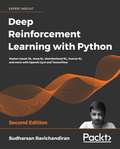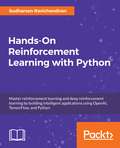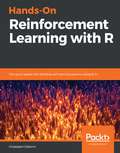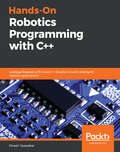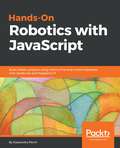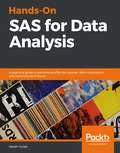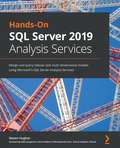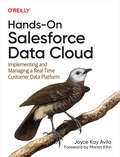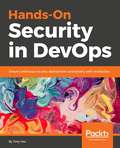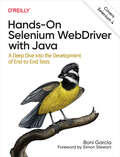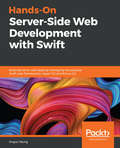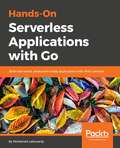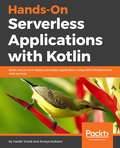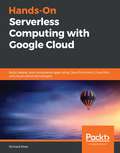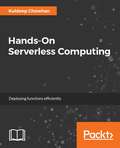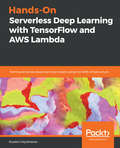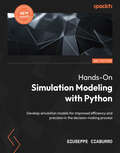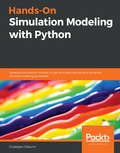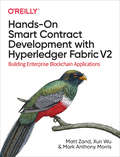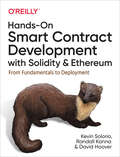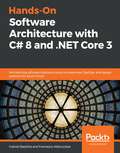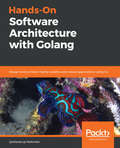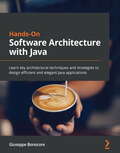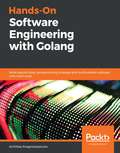- Table View
- List View
Hands-On Reinforcement Learning with Python - Second Edition: Master Reinforcement And Deep Reinforcement Learning Using Openai Gym And Tensorflow
by Sudharsan RavichandiranIf you’re a machine learning developer with little or no experience with neural networks interested in artificial intelligence and want to learn about reinforcement learning from scratch, this book is for you. Basic familiarity with linear algebra, calculus, and the Python programming language is required. Some experience with TensorFlow would be a plus.
Hands-On Reinforcement Learning with Python: Master reinforcement and deep reinforcement learning using OpenAI Gym and TensorFlow
by Sudharsan RavichandiranA hands-on guide enriched with examples to master deep reinforcement learning algorithms with PythonKey FeaturesYour entry point into the world of artificial intelligence using the power of PythonAn example-rich guide to master various RL and DRL algorithmsExplore various state-of-the-art architectures along with mathBook DescriptionReinforcement Learning (RL) is the trending and most promising branch of artificial intelligence. Hands-On Reinforcement learning with Python will help you master not only the basic reinforcement learning algorithms but also the advanced deep reinforcement learning algorithms.The book starts with an introduction to Reinforcement Learning followed by OpenAI Gym, and TensorFlow. You will then explore various RL algorithms and concepts, such as Markov Decision Process, Monte Carlo methods, and dynamic programming, including value and policy iteration. This example-rich guide will introduce you to deep reinforcement learning algorithms, such as Dueling DQN, DRQN, A3C, PPO, and TRPO. You will also learn about imagination-augmented agents, learning from human preference, DQfD, HER, and many more of the recent advancements in reinforcement learning.By the end of the book, you will have all the knowledge and experience needed to implement reinforcement learning and deep reinforcement learning in your projects, and you will be all set to enter the world of artificial intelligence.What you will learnUnderstand the basics of reinforcement learning methods, algorithms, and elementsTrain an agent to walk using OpenAI Gym and TensorflowUnderstand the Markov Decision Process, Bellman’s optimality, and TD learningSolve multi-armed-bandit problems using various algorithmsMaster deep learning algorithms, such as RNN, LSTM, and CNN with applicationsBuild intelligent agents using the DRQN algorithm to play the Doom gameTeach agents to play the Lunar Lander game using DDPGTrain an agent to win a car racing game using dueling DQNWho this book is forIf you’re a machine learning developer or deep learning enthusiast interested in artificial intelligence and want to learn about reinforcement learning from scratch, this book is for you. Some knowledge of linear algebra, calculus, and the Python programming language will help you understand the concepts covered in this book.
Hands-On Reinforcement Learning with R: Get up to speed with building self-learning systems using R 3.x
by Giuseppe CiaburroImplement key reinforcement learning algorithms and techniques using different R packages such as the Markov chain, MDP toolbox, contextual, and OpenAI Gym Key Features Explore the design principles of reinforcement learning and deep reinforcement learning models Use dynamic programming to solve design issues related to building a self-learning system Learn how to systematically implement reinforcement learning algorithms Book Description Reinforcement learning (RL) is an integral part of machine learning (ML), and is used to train algorithms. With this book, you'll learn how to implement reinforcement learning with R, exploring practical examples such as using tabular Q-learning to control robots. You'll begin by learning the basic RL concepts, covering the agent-environment interface, Markov Decision Processes (MDPs), and policy gradient methods. You'll then use R's libraries to develop a model based on Markov chains. You will also learn how to solve a multi-armed bandit problem using various R packages. By applying dynamic programming and Monte Carlo methods, you will also find the best policy to make predictions. As you progress, you'll use Temporal Difference (TD) learning for vehicle routing problem applications. Gradually, you'll apply the concepts you've learned to real-world problems, including fraud detection in finance, and TD learning for planning activities in the healthcare sector. You'll explore deep reinforcement learning using Keras, which uses the power of neural networks to increase RL's potential. Finally, you'll discover the scope of RL and explore the challenges in building and deploying machine learning models. By the end of this book, you'll be well-versed with RL and have the skills you need to efficiently implement it with R. What you will learn Understand how to use MDP to manage complex scenarios Solve classic reinforcement learning problems such as the multi-armed bandit model Use dynamic programming for optimal policy searching Adopt Monte Carlo methods for prediction Apply TD learning to search for the best path Use tabular Q-learning to control robots Handle environments using the OpenAI library to simulate real-world applications Develop deep Q-learning algorithms to improve model performance Who this book is for This book is for anyone who wants to learn about reinforcement learning with R from scratch. A solid understanding of R and basic knowledge of machine learning are necessary to grasp the topics covered in the book.
Hands-On Robotics Programming with C++: Leverage Raspberry Pi 3 and C++ libraries to build intelligent robotics applications
by Dinesh TavasalkarEnhance your programming skills to build exciting robotic projectsKey FeaturesBuild an intelligent robot that can detect and avoid obstacles and respond to voice commandsDetect and track objects and faces using OpenCVControl your robot with a GUI button designed using Qt5Book DescriptionC++ is one of the most popular legacy programming languages for robotics, and a combination of C++ and robotics hardware is used in many leading industries. This book will bridge the gap between Raspberry Pi and C/C++ programming and enable you to develop applications for Raspberry Pi. To follow along with the projects covered in the book, you can implement C programs in Raspberry Pi with the wiringPi library.With this book, you'll develop a fully functional car robot and write programs to move it in different directions. You'll then create an obstacle - avoiding robot using an ultrasonic sensor. Furthermore, you'll find out how to control the robot wirelessly using your PC/Mac. This book will also help you work with object detection and tracking using OpenCV, and guide you through exploring face detection techniques. Finally, you will create an Android app and control the robot wirelessly with an Android smartphone.By the end of this book, you will have gained experience in developing a robot using Raspberry Pi and C/C++ programming.What you will learnInstall software in Raspberry Pi compatible with C++ programmingProgram the Raspberry Pi in C++ to run a motorControl RPi-powered robot wirelessly with your laptop or PCProgram an RPi camera using OpenCV Control a Raspberry Pi robot with voice commandsImplement face and object detection with Raspberry PiWho this book is forThis book is for developers, programmers, and robotics enthusiasts interested in leveraging C++ to build exciting robotics applications. Prior knowledge of C++ is necessary to understand the projects covered in this book.
Hands-On Robotics with JavaScript: Build robotic projects using Johnny-Five and control hardware with JavaScript and Raspberry Pi
by Kassandra PerchLeverage Raspberry Pi 3 and different JavaScript platforms to build exciting Robotics projectsKey FeaturesBuild robots that light up and make noiseLearn to work with Raspberry Pi 3 and JavaScriptConnect your Johnny-Five projects to external APIs and create your own IoTBook DescriptionThere has been a rapid increase in the use of JavaScript in hardware and embedded device programming. JavaScript has an effective set of frameworks and libraries that support the robotics ecosystem.Hands-On Robotics with JavaScript starts with setting up an environment to program robots in JavaScript. Then, you will dive into building basic-level projects such as a line-following robot. You will walk through a series of projects that will teach you about the Johnny-Five library, and develop your skills with each project. As you make your way through the chapters, you’ll work on creating a blinking LED, before moving on to sensors and other more advanced concepts. You will then progress to building an advanced-level AI-enabled robot, connect their NodeBots to the internet, create a NodeBots Swarm, and explore MQTT.By the end of this book, you will have gained hands-on experience in building robots using JavaScriptWhat you will learnInstall and run Node.js and Johnny-Five on Raspberry PiAssemble, code, and run an LED projectLeverage JavaScript libraries to build exciting robotsUse sensors to collect data from the world around youEmploy servos and motors to make your project moveAdd internet capabilities to your Johnny-Five projectWho this book is forHands-On Robotics with JavaScript is for individuals who have prior experience with Raspberry Pi 3 and like to write sketches in JavaScript. Basic knowledge of JavaScript and Node.js will help you get the most out of this book.
Hands-On SAS for Data Analysis: A practical guide to performing effective queries, data visualization, and reporting techniques
by Harish GulatiLeverage the full potential of SAS to get unique, actionable insights from your data Key Features Build enterprise-class data solutions using SAS and become well-versed in SAS programming Work with different data structures, and run SQL queries to manipulate your data Explore essential concepts and techniques with practical examples to confidently pass the SAS certification exam Book Description SAS is one of the leading enterprise tools in the world today when it comes to data management and analysis. It enables the fast and easy processing of data and helps you gain valuable business insights for effective decision-making. This book will serve as a comprehensive guide that will prepare you for the SAS certification exam. After a quick overview of the SAS architecture and components, the book will take you through the different approaches to importing and reading data from different sources using SAS. You will then cover SAS Base and 4GL, understanding data management and analysis, along with exploring SAS functions for data manipulation and transformation. Next, you'll discover SQL procedures and get up to speed on creating and validating queries. In the concluding chapters, you'll learn all about data visualization, right from creating bar charts and sample geographic maps through to assigning patterns and formats. In addition to this, the book will focus on macro programming and its advanced aspects. By the end of this book, you will be well versed in SAS programming and have the skills you need to easily handle and manage your data-related problems in SAS. What you will learn Explore a variety of SAS modules and packages for efficient data analysis Use SAS 4GL functions to manipulate, merge, sort, and transform data Gain useful insights into advanced PROC SQL options in SAS to interact with data Get to grips with SAS Macro and define your own macros to share data Discover the different graphical libraries to shape and visualize data with Apply the SAS Output Delivery System to prepare detailed reports Who this book is for Budding or experienced data professionals who want to get started with SAS will benefit from this book. Those looking to prepare for the SAS certification exam will also find this book to be a useful resource. Some understanding of basic data management concepts will help you get the most out of this book.
Hands-On SQL Server 2019 Analysis Services: Design and query tabular and multi-dimensional models using Microsoft's SQL Server Analysis Services
by Adam Jorgensen Steven HughesGet up to speed with the new features added to Microsoft SQL Server 2019 Analysis Services and create models to support your businessKey FeaturesExplore tips and tricks to design, develop, and optimize end-to-end data analytics solutions using Microsoft's technologiesLearn tabular modeling and multi-dimensional cube design development using real-world examplesImplement Analysis Services to help you make productive business decisionsBook DescriptionSQL Server Analysis Services (SSAS) continues to be a leading enterprise-scale toolset, enabling customers to deliver data and analytics across large datasets with great performance. This book will help you understand MS SQL Server 2019's new features and improvements, especially when it comes to SSAS.First, you'll cover a quick overview of SQL Server 2019, learn how to choose the right analytical model to use, and understand their key differences. You'll then explore how to create a multi-dimensional model with SSAS and expand on that model with MDX. Next, you'll create and deploy a tabular model using Microsoft Visual Studio and Management Studio. You'll learn when and how to use both tabular and multi-dimensional model types, how to deploy and configure your servers to support them, and design principles that are relevant to each model. The book comes packed with tips and tricks to build measures, optimize your design, and interact with models using Excel and Power BI. All this will help you visualize data to gain useful insights and make better decisions. Finally, you'll discover practices and tools for securing and maintaining your models once they are deployed.By the end of this MS SQL Server book, you'll be able to choose the right model and build and deploy it to support the analytical needs of your business.What you will learnDetermine the best analytical model using SSASCover the core aspects involved in MDX, including writing your first queryImplement calculated tables and calculation groups (new in version 2019) in DAXCreate and deploy tabular and multi-dimensional models on SQL 2019Connect and create data visualizations using Excel and Power BIImplement row-level and other data security methods with tabular and multi-dimensional modelsExplore essential concepts and techniques to scale, manage, and optimize your SSAS solutionsWho this book is forThis Microsoft SQL Server book is for BI professionals and data analysts who are looking for a practical guide to creating and maintaining tabular and multi-dimensional models using SQL Server 2019 Analysis Services. A basic working knowledge of BI solutions such as Power BI and database querying is required.
Hands-On Salesforce Data Cloud: Implementing and Managing a Real-Time Customer Data Platform
by Joyce Kay AvilaLearn how to implement and manage a modern customer data platform (CDP) through the Salesforce Data Cloud platform. This practical book provides a comprehensive overview that shows architects, administrators, developers, data engineers, and marketers how to ingest, store, and manage real-time customer data.Author Joyce Kay Avila demonstrates how to use Salesforce's native connectors, canonical data model, and Einstein's built-in trust layer to accelerate your time to value. You'll learn how to leverage Salesforce's low-code/no-code functionality to expertly build a Data Cloud foundation that unlocks the power of structured and unstructured data. Use Data Cloud tools to build your own predictive models or leverage third-party machine learning platforms like Amazon SageMaker, Google Vertex AI, and Databricks.This book will help you:Develop a plan to execute a CDP project effectively and efficientlyConnect Data Cloud to external data sources and build out a Customer 360 Data ModelLeverage data sharing capabilities with Snowflake, BigQuery, Databricks, and AzureUse Salesforce Data Cloud capabilities for identity resolution and segmentationCreate calculated, streaming, visualization, and predictive insightsUse Data Graphs to power Salesforce Einstein capabilitiesLearn Data Cloud best practices for all phases of the development lifecycle
Hands-On Security in DevOps: Ensure continuous security, deployment, and delivery with DevSecOps
by Tony HsuProtect your organization's security at all levels by introducing the latest strategies for securing DevOpsKey FeaturesIntegrate security at each layer of the DevOps pipelineDiscover security practices to protect your cloud services by detecting fraud and intrusionExplore solutions to infrastructure security using DevOps principlesBook DescriptionDevOps has provided speed and quality benefits with continuous development and deployment methods, but it does not guarantee the security of an entire organization. Hands-On Security in DevOps shows you how to adopt DevOps techniques to continuously improve your organization’s security at every level, rather than just focusing on protecting your infrastructure.This guide combines DevOps and security to help you to protect cloud services, and teaches you how to use techniques to integrate security directly in your product. You will learn how to implement security at every layer, such as for the web application, cloud infrastructure, communication, and the delivery pipeline layers. With the help of practical examples, you’ll explore the core security aspects, such as blocking attacks, fraud detection, cloud forensics, and incident response. In the concluding chapters, you will cover topics on extending DevOps security, such as risk assessment, threat modeling, and continuous security.By the end of this book, you will be well-versed in implementing security in all layers of your organization and be confident in monitoring and blocking attacks throughout your cloud services.What you will learnUnderstand DevSecOps culture and organizationLearn security requirements, management, and metricsSecure your architecture design by looking at threat modeling, coding tools and practicesHandle most common security issues and explore black and white-box testing tools and practicesWork with security monitoring toolkits and online fraud detection rulesExplore GDPR and PII handling case studies to understand the DevSecOps lifecycleWho this book is forHands-On Security in DevOps is for system administrators, security consultants, and DevOps engineers who want to secure their entire organization. Basic understanding of Cloud computing, automation frameworks, and programming is necessary.
Hands-On Selenium WebDriver with Java: A Deep Dive into the Development of End-to-End Tests
by Boni GarciaGet started with Selenium WebDriver, the open source library for automating tests to ensure your web application performs as expected. In this practical hands-on book, author Boni Garcia takes Java developers through Selenium's main features for automating web navigation, browser manipulation, web element interaction, and more, with ready-to-be-executed test examples.You'll start by learning the core features of Selenium (composed of WebDriver, Grid, and IDE) and its ecosystem. Discover why Selenium WebDriver is the de facto library for developing end-to-end tests on your web application. You'll explore ways to use advanced Selenium WebDriver features, including using web browsers in Docker containers or the DevTools protocol. Selenium WebDriver examples in this book are available on GitHub.With this book, you'll learn how to:Set up a Java project containing end-to-end tests that use Selenium WebDriverConduct automated interaction with web applicationsUse strategies for managing browser-specific capabilities and cross-browser testingInteract with web forms, manage pop-up messages, and execute JavaScriptControl remote browsers and use advanced browser infrastructure for Selenium WebDriver tests in the cloudModel web pages using object-oriented classes to ease test maintenance and reduce code duplication
Hands-On Sencha Touch 2: A Real-World App Approach
by Lee BoonstraGet hands-on experience building speedy mobile web apps with Sencha Touch 2.3, the user interface JavaScript framework built specifically for the mobile Web. With this book, you’ll learn how to build a complete touch application, called Find a Cab, that has the look and feel of a native app on Android, iOS, Windows, and BlackBerry devices.In the process, you’ll work with Sencha’s model-view-controller (MVC) components for form handling, styling, integration with outside data, and other elements. The Sencha Touch learning curve can be steep, but if you’re familiar with JavaScript, HTML5, CSS3, and JSON, this guide will get you up to speed through real-world examples.Learn the fundamentals, including the class and layout systemsUse the Sencha MVC architecture to structure your codeImplement data models and stores, and create an event controllerMake remote connections by implementing server proxiesSave data offline by implementing client proxiesWork with view components such as maps, lists, and floating panelsImplement and handle forms, and construct a custom themeCreate production and native build packages
Hands-On Server-Side Web Development with Swift: Build dynamic web apps by leveraging two popular Swift web frameworks: Vapor 3.0 and Kitura 2.5
by Angus YeungThis book is about building professional web applications and web services using Swift and leveraging two popular Swift web frameworks: Vapor 3.0 and Kitura 2.5. We assume the readers to have some working knowledge of Swift programming language. The readers could be beginners of Swift programming, seasonal iOS or macOS developers, or software developers who want to work on practical Swift applications while learning the language itself. By the end of the book, you would be able to successfully create your own web applications and web services by leveraging the powerful ecosystem of Swift.
Hands-On Serverless Applications with Go: Build real-world, production-ready applications with AWS Lambda
by Mohamed LabouardyLearn to build, secure, deploy, and manage your serverless application in Golang with AWS Lambda Key FeaturesImplement AWS lambda to build scalable and cost-efficient applications in GoDesign and set the data flow between cloud services and custom business logicLearn to design Lambda functions using real-world examples and implementation scenariosBook DescriptionServerless architecture is popular in the tech community due to AWS Lambda. Go is simple to learn, straightforward to work with, and easy to read for other developers; and now it's been heralded as a supported language for AWS Lambda. This book is your optimal guide to designing a Go serverless application and deploying it to Lambda.This book starts with a quick introduction to the world of serverless architecture and its benefits, and then delves into AWS Lambda using practical examples. You'll then learn how to design and build a production-ready application in Go using AWS serverless services with zero upfront infrastructure investment. The book will help you learn how to scale up serverless applications and handle distributed serverless systems in production. You will also learn how to log and test your application.Along the way, you'll also discover how to set up a CI/CD pipeline to automate the deployment process of your Lambda functions. Moreover, you'll learn how to troubleshoot and monitor your apps in near real-time with services such as AWS CloudWatch and X-ray. This book will also teach you how to secure the access with AWS Cognito.By the end of this book, you will have mastered designing, building, and deploying a Go serverless application.What you will learnUnderstand how AWS Lambda works and use it to create an applicationUnderstand how to scaleup serverless applicationsDesign a cost-effective serverless application in AWSBuild a highly scalable and fault-tolerant CI/CD pipelineUnderstand how to troubleshoot and monitor serverless apps in AWSDiscover the working of APIs and single page applicationsBuild a production-ready serverless application in GoWho this book is forThis book is for Go developers who would like to learn about serverless architecture. Go programming knowledge is assumed. DevOps and Solution Architects who are interested in building serverless applications in Go can also choose this book.
Hands-On Serverless Applications with Kotlin: Develop scalable and cost-effective web applications using AWS Lambda and Kotlin
by Hardik Trivedi Ameya KulkarniChoose the right architecture and design it using design patterns to create a serverless application that cuts costs and is easily scalableKey FeaturesDesign enterprise ready serverless applications that effortlessly meet your customers’ requirementsEffectively deploy, manage, monitor, and orchestrate serverless applications using AWSUse Cloud9 to provision a secured development environment in the cloudBook DescriptionServerless is a cloud computing execution model where the cloud provider dynamically manages the allocation and provisioning of servers. Many companies have started using serverless architectures to cut costs and improve scalability. Hands-On Serverless Applications with Kotlin is your one-stop guide to designing serverless architectures for your applications with AWS and Kotlin.To start with, you’ll explore the fundamentals of serverless architecture and how AWS Lambda functions work. You will then learn to design, build, secure, and deploy your application to production. In addition to these activities, you’ll understand how to implement non-functional requirements such as auditing and logging. Moving on, you’ll discover how to scale up and orchestrate serverless applications using an open source framework and handle distributed serverless systems in production. By the end of the book, you’ll have gained the knowledge needed to build scalable and cost-efficient Kotlin applications with a serverless framework.What you will learnDesign a serverless architectureUse AWS Lambda to contain your serverless APIExplore the various ways to keep serverless apps safe and secureUnderstand how a serverless API allows you to use huge infrastructure and cut costsDiscover how to handle distributed systems in KotlinDesign the data flow between cloud services and custom business logicSecure your Kotlin AWS serverless applicationMaster Kotlin design patterns for serverless applicationsWho this book is forHands-On Serverless Applications with Kotlin is for you if you are a Kotlin developer who wants to learn about serverless architectures. It is assumed that you have some knowledge of Kotlin programming and AWS.
Hands-On Serverless Computing with Google Cloud: Build, deploy, and containerize apps using Cloud Functions, Cloud Run, and cloud-native technologies
by Richard RoseEffectively deploy fully managed workloads using Google Cloud's serverless services Key Features Use real-world use cases to understand the core functionalities of Functions as a Service Explore the potential of Cloud Run, Knative, Cloud Build, Google Kubernetes Engine, and Cloud Storage Get to grips with architectural decisions, seamless deployments, containerization, and serverless solutions Book Description Google Cloud's serverless platform allows organizations to scale fully managed solutions without worrying about the underlying infrastructure. With this book, you will learn how to design, develop, and deploy full stack serverless apps on Google Cloud. The book starts with a quick overview of the Google Cloud console, its features, user interface (UI), and capabilities. After getting to grips with the Google Cloud interface and its features, you will explore the core aspects of serverless products such as Cloud Run, Cloud Functions and App Engine. You will also learn essential features such as version control, containerization, and identity and access management with the help of real-world use cases. Later, you will understand how to incorporate continuous integration and continuous deployment (CI/CD) techniques for serverless applications. Toward the concluding chapters, you will get to grips with how key technologies such as Knative enable Cloud Run to be hosted on multiple platforms including Kubernetes and VMware. By the end of this book, you will have become proficient in confidently developing, managing, and deploying containerized applications on Google Cloud. What you will learn Explore the various options for deploying serverless workloads on Google Cloud Determine the appropriate serverless product for your application use case Integrate multiple lightweight functions to build scalable and resilient services Increase productivity through build process automation Understand how to secure serverless workloads using service accounts Build a scalable architecture with Google Cloud Functions and Cloud Run Who this book is for If you are a cloud administrator, architect, or developer who wants to build scalable systems and deploy serverless workloads on Google Cloud, then this book is for you. To get the most out of this book, a basic understanding of the serverless ecosystem and cloud computing will be beneficial.
Hands-On Serverless Computing: Build, run and orchestrate serverless applications using AWS Lambda, Microsoft Azure Functions, and Google Cloud Functions
by Kuldeep ChowhanDeploy functions efficiently using different cloud-based serverless offeringsKey FeaturesUnderstand the concept of Function-as-a-ServiceImplement Serverless solutions using AWS Lambda, Azure Functions and Google Cloud FunctionsPractical approach towards choosing the best tool for your serverless environmentBook DescriptionServerless applications and architectures are gaining momentum and are increasingly being used by companies of all sizes. Serverless software takes care of many problems that developers face when running systems and servers, such as fault tolerance, centralized logging, horizontal scalability, and deployments.You will learn how to harness serverless technology to rapidly reduce production time and minimize your costs, while still having the freedom to customize your code, without hindering functionality. Upon finishing the book, you will have the knowledge and resources to build your own serverless application hosted in AWS, Microsoft Azure, or Google Cloud Platform, and will have experienced the benefits of event-driven technology for yourself.This hands-on guide dives into the basis of serverless architectures and how to build them using Node.js as a programming language, Visual Studio Code for code editing, and Postman for quickly and securely developing applications without the hassle of configuring and maintaining infrastructure on three public cloud platforms.What you will learnUnderstand the benefts of serverless computing and know when to use itDevelop serverless applications on AWS, Azure, and Google CloudGet to grips with Function as a Service (FaaS)Apply triggers to serverless functionsBuild event-driven apps using serverless frameworksUse the Node.js programming language to build serverless appsUse code editors, such as Visual Studio Code, as development environmentsMaster the best development practices for creating scalable and practical solutionsWho this book is forThis book is targeted towards developers, system administrators or any stakeholder working in the Serverless environment and want to understand how functions work.Basic idea of serverless architecture can be an added advantage
Hands-On Serverless Deep Learning with TensorFlow and AWS Lambda: Training serverless deep learning models using the AWS infrastructure
by Rustem FeyzkhanovUse the serverless computing approach to save time and money Key Features Save your time by deploying deep learning models with ease using the AWS serverless infrastructure Get a solid grip on AWS services and use them with TensorFlow for efficient deep learning Includes tips, tricks and best practices on serverless deep learning that you can use in a production environment Book Description One of the main problems with deep learning models is finding the right way to deploy them within the company's IT infrastructure. Serverless architecture changes the rules of the game—instead of thinking about cluster management, scalability, and query processing, it allows us to focus specifically on training the model. This book prepares you to use your own custom-trained models with AWS Lambda to achieve a simplified serverless computing approach without spending much time and money. You will use AWS Services to deploy TensorFlow models without spending hours training and deploying them. You'll learn to deploy with serverless infrastructures, create APIs, process pipelines, and more with the tips included in this book. By the end of the book, you will have implemented your own project that demonstrates how to use AWS Lambda effectively so as to serve your TensorFlow models in the best possible way. What you will learn Gain practical experience by working hands-on with serverless infrastructures (AWS Lambda) Export and deploy deep learning models using Tensorflow Build a solid base in AWS and its various functions Create a deep learning API using AWS Lambda Look at the AWS API gateway Create deep learning processing pipelines using AWS functions Create deep learning production pipelines using AWS Lambda and AWS Step Function Who this book is for This book will benefit data scientists who want to learn how to deploy models easily and beginners who want to learn about deploying into the cloud. No prior knowledge of TensorFlow or AWS is required.
Hands-On Simulation Modeling with Python: Develop simulation models for improved efficiency and precision in the decision-making process, 2nd Edition
by Giuseppe CiaburroLearn to construct state-of-the-art simulation models with Python and enhance your simulation modelling skills, as well as create and analyze digital prototypes of physical models with easeKey FeaturesUnderstand various statistical and physical simulations to improve systems using PythonLearn to create the numerical prototype of a real model using hands-on examplesEvaluate performance and output results based on how the prototype would work in the real worldBook DescriptionSimulation modelling is an exploration method that aims to imitate physical systems in a virtual environment and retrieve useful statistical inferences from it. The ability to analyze the model as it runs sets simulation modelling apart from other methods used in conventional analyses. This book is your comprehensive and hands-on guide to understanding various computational statistical simulations using Python. The book begins by helping you get familiarized with the fundamental concepts of simulation modelling, that'll enable you to understand the various methods and techniques needed to explore complex topics. Data scientists working with simulation models will be able to put their knowledge to work with this practical guide. As you advance, you'll dive deep into numerical simulation algorithms, including an overview of relevant applications, with the help of real-world use cases and practical examples. You'll also find out how to use Python to develop simulation models and how to use several Python packages. Finally, you'll get to grips with various numerical simulation algorithms and concepts, such as Markov Decision Processes, Monte Carlo methods, and bootstrapping techniques.By the end of this book, you'll have learned how to construct and deploy simulation models of your own to overcome real-world challenges.What you will learnGet to grips with the concept of randomness and the data generation processDelve into resampling methodsDiscover how to work with Monte Carlo simulationsUtilize simulations to improve or optimize systemsFind out how to run efficient simulations to analyze real-world systemsUnderstand how to simulate random walks using Markov chainsWho this book is forThis book is for data scientists, simulation engineers, and anyone who is already familiar with the basic computational methods and wants to implement various simulation techniques such as Monte-Carlo methods and statistical simulation using Python.
Hands-On Simulation Modeling with Python: Develop simulation models to get accurate results and enhance decision-making processes
by Giuseppe CiaburroEnhance your simulation modeling skills by creating and analyzing digital prototypes of a physical model using Python programming with this comprehensive guide Key Features Learn to create a digital prototype of a real model using hands-on examples Evaluate the performance and output of your prototype using simulation modeling techniques Understand various statistical and physical simulations to improve systems using Python Book Description Simulation modeling helps you to create digital prototypes of physical models to analyze how they work and predict their performance in the real world. With this comprehensive guide, you'll understand various computational statistical simulations using Python. Starting with the fundamentals of simulation modeling, you'll understand concepts such as randomness and explore data generating processes, resampling methods, and bootstrapping techniques. You'll then cover key algorithms such as Monte Carlo simulations and Markov decision processes, which are used to develop numerical simulation models, and discover how they can be used to solve real-world problems. As you advance, you'll develop simulation models to help you get accurate results and enhance decision-making processes. Using optimization techniques, you'll learn to modify the performance of a model to improve results and make optimal use of resources. The book will guide you in creating a digital prototype using practical use cases for financial engineering, prototyping project management to improve planning, and simulating physical phenomena using neural networks. By the end of this book, you'll have learned how to construct and deploy simulation models of your own to overcome real-world challenges. What you will learn Gain an overview of the different types of simulation models Get to grips with the concepts of randomness and data generation process Understand how to work with discrete and continuous distributions Work with Monte Carlo simulations to calculate a definite integral Find out how to simulate random walks using Markov chains Obtain robust estimates of confidence intervals and standard errors of population parameters Discover how to use optimization methods in real-life applications Run efficient simulations to analyze real-world systems Who this book is for Hands-On Simulation Modeling with Python is for simulation developers and engineers, model designers, and anyone already familiar with the basic computational methods that are used to study the behavior of systems. This book will help you explore advanced simulation techniques such as Monte Carlo methods, statistical simulations, and much more using Python. Working knowledge of Python programming language is required.
Hands-On Smart Contract Development with Hyperledger Fabric V2: Building Enterprise Blockchain Applications
by Xun Brian Wu Matt Zand Mark Anthony MorrisBlockchain technology continues to disrupt a wide variety of organizations, from small businesses to the Fortune 500. Today hundreds of blockchain networks are in production, including many built with Hyperledger Fabric. This practical guide shows developers how the latest version of this blockchain infrastructure provides an ideal foundation for developing enterprise blockchain applications or solutions.Authors Matt Zand, Xun Wu, and Mark Anthony Morris demonstrate how the versatile design of Hyperledger Fabric 2.0 satisfies a broad range of industry use cases. Developers with or without previous Hyperledger experience will discover why no other distributed ledger technology framework enjoys such wide adoption by cloud service providers such as Amazon, Alibaba, IBM, Google, and Oracle.Walk through the architecture and components of Hyperledger Fabric 2.0Migrate your current Hyperledger Fabric projects to version 2.0Develop blockchain applications on the Hyperledger platform with Node.jsDeploy and integrate Hyperledger on Amazon Managed Blockchain, IBM Cloud, and Oracle CloudDevelop blockchain applications with Hyperledger Aries, Avalon, Besu, and GridBuild end-to-end blockchain supply chain applications with Hyperledger
Hands-On Smart Contract Development with Solidity and Ethereum: From Fundamentals to Deployment
by Kevin Solorio Randall Kanna David H. HooverReady to dive into smart contract development for the blockchain? With this practical guide, experienced engineers and beginners alike will quickly learn the entire process for building smart contracts for Ethereum--the open source blockchain-based distributed computing platform. You'llget up to speed with the fundamentals and quickly move into builder mode.Kevin Solorio, Randall Kanna, and Dave Hoover show you how to create and test your own smart contract, create a frontend for users to interact with, and more. It's the perfect resource for people who want to break into the smart contract field but don't know where to start.In four parts, this book helps you:Explore smart contract fundamentals, including the Ethereum protocol, Solidity programming language, and the Ethereum Virtual MachineDive into smart contract development using Solidity and gain experience with Truffle framework tools for deploying and testing your contractsUse Web3 to connect your smart contracts to an applicationso users can easily interact with the blockchainExamine smart contract security along with free online resources for smart contract security auditing
Hands-On Software Architecture with C# 8 and .NET Core 3: Architecting software solutions using microservices, DevOps, and design patterns for Azure Cloud
by Francesco Abbruzzese Gabriel BaptistaDesign scalable and high-performance enterprise applications using the latest features of C# 8 and .NET Core 3 Key Features Become a software architect capable of creating modular apps for specific business needs Design high-performance software systems using the latest features of C# 8 and .NET Core 3 Solve scalability problems in web apps using enterprise architectural patterns Book Description Software architecture is the practice of implementing structures and systems that streamline the software development process and improve the quality of an app. With this software architecture book, you'll follow a hands-on approach to learning various architectural methods that will help you develop and deliver high-quality products. You'll begin by understanding how to transform user requirements into architectural needs and exploring the differences between functional and non-functional requirements. Next, you'll explore how to carefully choose a cloud solution for your infrastructure, along with covering dos and don'ts that will help you manage your app in a cloud-based environment. Later chapters will cover techniques and processes such as DevOps, microservices, and continuous integration, along with providing insights into implementing them using Microsoft technologies such as ASP.NET Core, the Entity Framework, Cosmos DB, and Azure DevOps. You will also learn about testing frameworks and automation tools that will help you through the development process. Finally, you'll discover design patterns and various software approaches that will allow you to solve common problems faced during development. By the end of this book, you'll be able to develop and deliver highly scalable enterprise-ready apps that meet customers' business needs. What you will learn Overcome real-world architectural challenges and solve design consideration issues Apply architectural approaches like Layered Architecture, service-oriented architecture (SOA), and microservices Learn to use tools like containers, Docker, and Kubernetes to manage microservices Get up to speed with Azure Cosmos DB for delivering multi-continental solutions Learn how to program and maintain Azure Functions using C# Understand when to use test-driven development (TDD) as an approach for software development Write automated functional test cases for your projects Who this book is for This book is for engineers and senior developers aspiring to become architects or looking to build enterprise applications with the .NET Stack. Experience with C# and .NET is required to understand this book.
Hands-On Software Architecture with Golang: Design And Architect Highly Scalable And Robust Applications Using Go
by Jyotiswarup RaiturkarThis book is for software developers, architects and CTOs looking to use Go in their software architecture. The book assumes general programming knowledge and architecture concepts. Familiarity with Go is not required and programming constructs are introduced with concepts.
Hands-On Software Architecture with Java
by Giuseppe BonocoreThis book is for Java software engineers who want to become software architects and learn everything a modern software architect needs to know. The book is also for software architects, technical leaders, vice presidents of software engineering, and CTOs looking to extend their knowledge and stay up to date with the latest developments in the field of software architecture.
Hands-On Software Engineering with Golang: Move beyond basic programming to design and build reliable software with clean code
by Achilleas AnagnostopoulosExplore software engineering methodologies, techniques, and best practices in Go programming to build easy-to-maintain software that can effortlessly scale on demand Key Features Apply best practices to produce lean, testable, and maintainable Go code to avoid accumulating technical debt Explore Go's built-in support for concurrency and message passing to build high-performance applications Scale your Go programs across machines and manage their life cycle using Kubernetes Book Description Over the last few years, Go has become one of the favorite languages for building scalable and distributed systems. Its opinionated design and built-in concurrency features make it easy for engineers to author code that efficiently utilizes all available CPU cores. This Golang book distills industry best practices for writing lean Go code that is easy to test and maintain, and helps you to explore its practical implementation by creating a multi-tier application called Links 'R' Us from scratch. You'll be guided through all the steps involved in designing, implementing, testing, deploying, and scaling an application. Starting with a monolithic architecture, you'll iteratively transform the project into a service-oriented architecture (SOA) that supports the efficient out-of-core processing of large link graphs. You'll learn about various cutting-edge and advanced software engineering techniques such as building extensible data processing pipelines, designing APIs using gRPC, and running distributed graph processing algorithms at scale. Finally, you'll learn how to compile and package your Go services using Docker and automate their deployment to a Kubernetes cluster. By the end of this book, you'll know how to think like a professional software developer or engineer and write lean and efficient Go code. What you will learn Understand different stages of the software development life cycle and the role of a software engineer Create APIs using gRPC and leverage the middleware offered by the gRPC ecosystem Discover various approaches to managing package dependencies for your projects Build an end-to-end project from scratch and explore different strategies for scaling it Develop a graph processing system and extend it to run in a distributed manner Deploy Go services on Kubernetes and monitor their health using Prometheus Who this book is for This Golang programming book is for developers and software engineers looking to use Go to design and build scalable distributed systems effectively. Knowledge of Go programming and basic networking principles is required.
